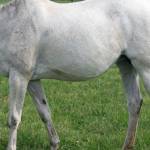Marine-Derived Omega-3s Benefit Foals Before Birth

Omega-3 fatty acids have many favorable health effects on horses, including joint, respiratory, and reproductive benefits. Supplementing pregnant mares with omega-3s late in gestation has advantages for their developing foals. However, not all types of omega-3 supplements fed to mares have the same effectiveness.
The two major sources of omega-3 fatty acids for horses are:
- Plant-derived short-chain omega-3 fatty acids, primarily alpha linoleic acid (ALA). High levels of ALA are found in flaxseed, canola oil, and other feedstuffs, but ALA must be converted by the horse to long-chain omega-3 fatty acids, including DHA (docosahexaenoic acid) and EPA (eicosapentaenoic acid) for optimal use by horses.
- Marine-derived omega-3s rich in the specific omega-3 fatty acids DHA and EPA. Providing a direct source of these omega-3 fatty acids may be preferred, as the conversion of ALA to long-chain fatty acids is limited in horses.
No study has determined if the omega-3s offered in a mare’s diet actually reaches her unborn foal.
To fill this knowledge gap, researchers recently designed a study to measure omega-3 fatty acid levels in foals from supplemented mares. Three diets that provided a similar total amount of omega-3 fatty acids from two different sources were used. The first was a control diet, the second was the control diet plus a commercial flaxseed supplement, and the third was the control diet with a commercial marine-derived omega-3 supplement.
When mares were offered each of these supplements during the last 30 days of gestation, only marine-derived supplementation resulted in a significant increase in DHA levels in foals.
The DHA measured in blood samples from foals born to mares offered only the control diet was 0.6 g/100 g of lipid (fat). In the foals from mares supplemented with the marine-derived omega-3, the DHA was significantly higher at 1.9 g/100 g lipid.
“No difference in foal DHA blood levels was observed between the control and flaxseed diets, which means these results support the recommendation to provide a direct source of DHA and EPA due to the low conversion rate of ALA to DHA,” relayed Catherine Whitehouse, M.S., a nutritionist for Kentucky Equine Research.
Even though mares were supplemented during the first five days after foaling and foals were nursing those mares, DHA levels declined rapidly. By day five, DHA levels were similar across all diets. On day 30, which was 25 days after the mares were no longer supplemented, the DHA blood level of the foals was only 0.1 g/100 g lipid.
“Continuing to supplement mares throughout nursing until weaning may help maintain higher DHA levels in foals after foaling, providing long-term advantages to growth and development,” suggested Whitehouse.
EO-3, a marine-derived omega-3 supplement developed by Kentucky Equine Research, provides research-proven levels of DHA and EPA, can be top-dressed onto feed easily.
*Snyder, J. N. Shost, R. Miller, K. Fikes, R. Smith, B. Corl, A. Wagner, I. Girard, and J. Suagee-Bedore 2021. Late gestation supplementation of long-chain fatty acids increases foal docosahexaenoic acid concentrations at birth. Journal of Equine Veterinary Science 100:103522.








